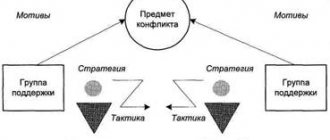We have already written about conflicts in the article “Resolving conflict is not a problem” and other materials. This time we will focus on conflictogens - conflict provocateurs.
People with conflicts are not only those who consciously go into conflict. These are also people who use elements in their speech, gestures and behavior that cause conflict.
A conflictogen can be called any word or action that can lead to a situation that can develop into a conflict.
The nature of conflict agents and their properties
Conflicts arise due to unmet needs and differences of views between people.
Modern psychologists believe that in many situations conflict is necessary for effective interaction between family members and the work team. The main thing is to understand its cause and be able to manage it competently. Properly constructed conflicts make it possible to identify hidden contradictions and disagreements, find methods to overcome them and establish even more harmonious interaction.
There are situations when the conflict is exclusively negative. It is a manifestation of threat, hostility, resentment or envy. Often this opinion is justified and fair.
The intentional use of conflict agents manifests itself in different ways, for example:
- the desire to insult a person by showing open distrust;
- emphasizing the differences between oneself and the other participant in communication;
- an attempt to rise above the background of the interlocutor;
- emphasizing one's own merits and belittling the merits of other people;
- devaluation of values, hobbies and other important parts of the opponents’ personality.
Such negatively colored conflictogens are used to solve their own psychological problems. They are often based on their own low self-esteem, although the instigator of the unpleasant situation may not realize and deny this.
Doctor, everything annoys me
There is an expression: “This world is created to infuriate us.” In general, whoever is looking for... well, you get the idea. A hidden bomb is too low a salary, a bad smell from a neighbor, the stupidity of modern youth, and even the color of a journalist’s blouse.
Moreover, sometimes the “misbehavior” of home appliances, for example, is a negative factor. You've probably noticed that, according to Murphy's law, it either malfunctions at the same time (apparently, it's more fun this way), and precisely at the moment when you urgently need to watch a disk/print a file/whip cream for a ready-made cake, or it breaks down exactly a few days after end of warranty. Again, it all depends on your reaction and whether the glass was half empty or half full (and on the contents you poured into it the night before). While a lively optimist will laugh and say: “Anything can happen - apparently, their time has expired,” a fan of dull determinism will suspect a worldwide conspiracy here.
Types and examples of subjective type conflictogens
Conflict triggers, in most cases, are subjective in nature and trigger situations consisting of several phases:
- grounds;
- increasing tension;
- the flow of one conflict situation into another;
- transitional, in which a resource is generated for cooperation, competition, and a way out of a difficult situation.
Subjective conflictogens provoke other sharp clashes.
Conflict-generating actions
They are manifested by violation of clearly established rules in a certain community, inappropriate aggression, as well as other forms of behavior. Most often, conflicting actions can be recognized by:
- the desire for superiority over others (using a condescending tone in conversation, a dismissive attitude, categorical judgments, banter, interrupting the interlocutor, boasting, raising one's voice);
- aggressive manifestations (situational, arising under certain circumstances, due to characterological characteristics);
- egocentrism (respecting only one’s own and ignoring the interests of other people).
Violation of rules (neglect of ethical standards, discipline, labor regulations, safety precautions, traffic rules) are also considered factors that can trigger a conflict.
Conflict situations
There are many situations. which can become conflictogens. They manifest themselves as overt or hidden aggression. It is not difficult to notice that a person is behaving in such a way that a scandal may break out if you carefully observe his behavior. The most common conflict situations are:
- open display of mistrust;
- neglecting the interlocutor’s words, interrupting;
- devaluation of merit, reduction of the opponent’s importance;
- emphasis on the differences between oneself and the interlocutor (in one’s favor);
- reluctance to admit one’s own mistakes, emphasizing the mistakes and wrongs of others;
- imposing one's own views;
- insincerity in judgments and statements;
- rapid development of relationships and abrupt breakdown of contacts;
- denial and unwillingness to listen to another person's point of view.
Hidden aggression manifests itself in a veiled way, so that the opponent feels it, but cannot prove it. A person who shows hidden aggression is dangerous for the psychological atmosphere in the team - the situation escalates gradually, but is resolved with a sudden powerful “explosion” of negative emotions.
When interacting personally with a hidden aggressor, his opponent experiences severe psychological discomfort, misunderstanding of the situation, or a sudden desire to fight back the aggression and interrupt contact.
Conflict words
Verbal conflictogens are among those that are used more often than others. Conflict can be triggered by words from the category:
- manifestations of mistrust;
- insults;
- threats;
- ridicule;
- comparisons;
- manifestations of a negative attitude;
- orders and obligations;
- accusations.
Often people utter conflict-generating words unconsciously, not wanting to harm their interlocutor. But in some situations, the aggressor specifically uses conflict-generating statements in order to provoke and evoke a response from the interlocutor, as well as to achieve a selfish goal.
Conflicts related to information
Information conflictogens are not obvious; only very attentive people or professional psychologists can recognize them immediately. The provocateurs of the confrontation can be considered;
- withholding, distorting or providing incomplete information in response to a request;
- the use of professional slang, speech structures that are too difficult to understand, aimed at showing one’s own superiority over the interlocutor;
- whispering, mystery in the presence of other people;
- drawing attention to yourself or, conversely, refusing to communicate;
- plagiarism.
Finding someone to blame is also one of the information conflictogens. It is based on a negative assessment of other people and can provoke conflict.
May provoke...
Conflict is a provocative factor. Any object, thing, look, action or inaction can provoke a conflict It happens that a person, having become a source of conflict, says: “I didn’t do anything” or “I didn’t say a word.” As we can see, this does not mean that he did not use a conflict agent.
The key word here is “may.” It can provoke, but is not a provocation in itself; it only works in a certain context. This is why conflictogens are dangerous. It can provoke, or it can remain an ordinary everyday object, a word, an action. Therefore, it is not always possible to identify and exclude such factors. It is important to take into account one more concept - “ provoking moment ”. This is the context in which the conflictogen is put into action.
For example, it can be argued that the provoking moment will be the accumulation of conflict agents in the company. Or one could also argue that corporate team building events minimize the risk of conflict.
Looking ahead, let's name some conflictogens: categoricalness, banter, violation of ethical rules, the habit of giving advice, words like “you should”, “you don’t understand”, any symbols of belonging to any ideological group. By themselves, they may not even cause irritation, but sometimes, under a certain set of circumstances, any of the above can cause a real fire.
Conflict management training first introduces the theory of conflict, after which it teaches through examples. Let's return to theory, after which we will list the types and examples of conflictogens.
Working with conflict agents
It is possible to reduce the frequency and severity of conflicts. In the work collective and family, this can be achieved by identifying the causes and forming an adequate attitude towards the factors in the development of conflicts.
The work of a psychologist is carried out in several stages:
- identifying triggers for conflict situations;
- developing the skill of understanding one’s own and other people’s needs;
- learning to use the most clear and correct statements.
The work requires effort on the part of not only the conflict specialist, but also his client (group of people). But efforts to create a psychologically comfortable environment in the family and team always pay off.
Overcoming selfishness
As you know, any extreme in anything is a disadvantage. This, of course, also applies to selfishness brought to such a state when a person becomes unloved by everyone, including loved ones.
But the other extreme - pronounced altruism - is also not the best character trait. This can be compared to the following: virtue is certainly an admirable quality of personality, but if it is taken to the extreme, it turns into a vice. So it is in our case: egoism and altruism are extreme personal characteristics that, apparently, should be avoided.
How? The answer is: by combining them together. You can be guided in life by the principles of either “enlightened egoism” (author - Aristotle), or “reasonable egoism” (F.M. Dostoevsky), or “altruistic egoism” (this principle was substantiated by the Canadian psychologist Hans Selye).
The essence of the three approaches is that by doing good to others, a person does it first of all to himself. To yourself, but through another. This is the only way to interact with people that will allow you to overcome your own selfishness.
Explore today
Conflictogens: classification
Conflict agents are often used in everyday communication. They manifest themselves verbally and non-verbally.
A grin in response to the words of the interlocutor, arms crossed on the chest and a glance from under his brows are non-verbal manifestations of aggression. The most intense non-verbal conflictogen is open ignoring. For a person who is not noticed, it is very painful and is associated with the fear of rejection, which begins in early childhood.
Verbal conflictogens are associated with the manifestation of open or hidden aggression in statements, for example:
- what are you talking about?!
- can you hear yourself?
- but who would speak;
- Do not talk rubbish;
- I don't even want to talk to you.
Verbal manifestations of aggression also include open devaluation of a person and his achievements. Aggression is also hidden behind comparison with others or with oneself not in favor of the interlocutor, discussion of third parties in their absence.
The classification of conflictogens identifies 5 main reasons that provoke aggression towards other people.
Manifestations of aggressiveness
Aggression arises as a result of frustration, when a person faces insurmountable obstacles, has unfulfilled desires and unmet needs. A prolonged stay in frustration provokes an increase in anxiety, increases the feeling of one’s own inferiority, and awakens aggression towards other people.
Striving for Excellence
Gaining power over others, the desire to emphasize one’s own superiority arises against the background of a complex of one’s own inferiority deeply hidden in the unconscious. People striving for superiority are hostile to others, self-confident, boastful, malicious, and envious.
They often structure situations so that others see their grandeur. External shine and approval from strangers are much more important than real success.
Selfishness
For egoists, only their own interests and values are important. Conflict situations arise against the backdrop of the fact that a selfish person seeks to satisfy his needs by infringing on the interests of other people - deceiving them, shifting responsibility for his own mistakes, withholding information.
Breaking the rules
Any rules establish the framework within which a person can act so as not to cause damage to society, family, or team. By violating the boundaries, the instigator of the conflict makes it clear to others that he does not respect their interests.
Unfavorable set of circumstances
Often conflicts flare up suddenly. The reason for such situations is a lack of resources among their participants, which arose due to severe stress, fatigue, and physical illness.
How to proceed?
It’s unpleasant to realize that various types of conflictogens can make you angry. You need to be prepared to calculate possible courses of action when they arise:
- escalation of the conflict with the aim of detente (come on, repeat, what did you call me?!),
- ignore: pretend that you don’t notice anything and are immersed in your own thoughts - especially if you’re driving nearby, and a drunk doesn’t care who you bother with (what kind of fat woman is that, I don’t know anything, and it seems they sent me a very interesting message in the messenger),
- a way to put yourself in the place of your opponent (I also wanted to win this competition, but for you this is a matter of self-respect and a desperate last chance, because I only have a year left to work here, and I will still have many opportunities to realize my potential),
- compromise (okay, calm down, I won’t go anywhere today and throw my junk off the mezzanine, but tomorrow you’ll cook my favorite pie and let me stay with friends),
- sometimes it’s enough just to talk, express your wishes and explain your actions - maybe the other side is not aware that you are not a malicious saboteur, but have your own plan (no, I didn’t throw my socks away, but put them out for air - a friend calls me to help at two o’clock with repairs, and then I’ll throw them in the wash),
- avoiding conflict - in the literal and figurative sense, is possible if there are communication problems or lack of time (yes, yes, there is sawdust in my head, I’m the same dunce as all teenagers, but I’ll go, grandma, for a walk - on the street it’s so warm, and the other parasites have been waiting in the yard for a long time),
- A smile makes a gloomy day brighter, and an unexpected joke can completely defuse the situation (man, don’t go broke - you’re so cute, but you ruin the mood for yourself and people).
The main thing here is to choose the right option that will lead to neutralization of the conflict. Remember: we have the power to prevent or stop the development of a tense situation by recognizing the source of danger in time and determining the desired strategy of behavior.
Author: Maria Nefedova
Conflictogens: constructive interaction
Conflicts interfere with normal interaction, productive work, and solving assigned tasks. Few people manage to avoid tense situations completely.
To reduce the frequency of conflicts and minimize their destructive consequences, you need to have a clear understanding of yourself, your own strengths and weaknesses, and learn to understand and direct emotions in a peaceful direction. Stable self-esteem, coupled with normal physical well-being, makes it possible to react more calmly to any difficulties and not get involved in conflict situations.
Irina Sherbul
Criminal liability for online extortion
The act under this article entails punishment in the form of:
- restrictions of freedom for up to 4 years;
- forced labor for up to 4 years with or without restriction of freedom for up to 2 years;
- arrest for up to 6 months;
- imprisonment for up to 4 years with a fine of 80 thousand rubles;
- arrest for up to 7 years (if the criminals acted as part of a group and extorted more than 25 thousand rubles);
- imprisonment for 15 years (organized group + extortion of more than 1 million rubles);
- deprivation of the right to carry out certain types of activities or work in a specific position for a period of up to 36 months.
In addition, for blackmailing VKontakte with sending compromising video photographs of the criminal, he will be punished in accordance with Article 137 of the Criminal Code of the Russian Federation “Violation of privacy” in the form of arrest for up to two years or a fine in the amount of 25 thousand rubles.
Actions of attackers to hack correspondence on a social network are classified separately. Responsibility for them is provided for in Article 138 of the Criminal Code of the Russian Federation and is punishable by a fine of up to 80 thousand rubles or community service.
Display of aggression
In the absence of a suitable object, the aggressor sometimes chooses any
It doesn't matter what he finds fault with. No matter what you do, everything is bad
Did you make scrambled eggs for breakfast? “It’s terrible, there’s so much cholesterol in there, you want my death!” Have you cooked porridge? Disgusting, “you know I eat scrambled eggs in the morning!”
There are several options for behavior here. If you also don’t mind unloading, then you can just quarrel to your heart’s content and even break dishes (if it makes both of you feel better after that). But the choice of response will be more effective the better you know your opponent. If after the phrase “Yes, dad, I did something terrible again, I repent,” he calms down, you will have to choose this option. Sometimes it is enough to remain silent, not paying attention to the provoking statement.
But not everyone will be reassured by the passive acceptance of guilt - a conflicted person is not looking for justice, he wants to let off steam, or he simply asserts himself at the expense of his neighbor. Some deliberately seek to aggravate the situation, try to make people cry, and spoil the mood. If the situation becomes tense on public transport, it is better to leave the cabin if possible. And when you have a conflict with a member of your household or with your boss, it will be difficult to “leave the cabin” (like during a flight).
Rudeness, categoricalness and communication in a negative way are communicative conflict generators (and some people simply have this style of conveying information). These also include various claims and statements addressed to a person in front of strangers. So it is advisable to “filter the market”, because even an unsuccessful joke in the spirit of “Be quiet, woman!” can lead to a whole host of problems.
Unfortunate coincidence
And further. It happens that the provocative factor is not actually such. It's just a coincidence or an accident. For example, you open the door when the bell rings, and a cheerful couple bursts into the hallway, insistently demanding an answer to two questions: why didn’t the owner come out and why isn’t the table set yet??! Apparently they were on the wrong floor.
What can you do in such a situation? Find out what happened and just smile, because in most cases what has been done cannot be undone. However, try to somehow help the person you upset and make an effort to correct the occasional mistake, whatever it may be. For example, in a cafe you were pushed and you poured a glass of water on a sitting person. Be sure to apologize and find a towel or cleansing wet wipes. Offer to order dessert as compensation. Who knows - maybe this bad day will end with a pleasant acquaintance?
Let's defuse the situation
In human communication, conflictogens often become a trigger for the emergence and intensification of confrontation
It is important to be able to control your own behavior and understand the reasons for your reaction to certain stimuli. It is also advisable to calculate the consequences in advance: for example, you go to visit and only on the spot inform that the doctor has forbidden your spouse to eat 99% of the dishes on the table
Then he sits with a sad look, demonstrating how sickening this celebration of life is. It was advisable to inform the hostess about dietary restrictions in advance or bring specially prepared food with you. After all, you came not so much to dine, but also to enjoy communication with pleasant people, right?
By the way, conflictology recommends distinguishing between irritating factors that provoke problems, an unstable situation and elements that enliven and “refresh” existence - for example, in the family. Sometimes the latter are beneficial (remember: “Darlings scold - are they just having fun?”). If the house is quiet and calm, then either both are angels, or... everyone has become indifferent to what the partner does, what he thinks about and what his partner desires.
Contents of conflict management include:
- forecasting, warning (stimulation), regulation, resolution;
2. forecasting, warning (stimulation), resolution;
3. forecasting, regulation, resolution;
4. forecasting, analysis, warning, resolution;
5. analysis of a conflict situation, forecasting, prevention, resolution.
11. The prerequisites for the development of the conflict are:
- sufficient maturity of the conflict, the need of the subjects of the conflict to resolve it, the availability of the necessary resources and means to resolve the conflict;
2. sufficient maturity of the conflict, high authority of one of the conflicting parties;
8 pages, 3839 words
Ethnic conflicts, ways to resolve them
... conflicts; classification of ethnic conflicts, methods of resolving ethnic conflicts; principles for resolving ethnic conflicts. 1. Causes of ethnic conflicts “Ethnic conflicts ... conflict in the situation of the conflict under consideration are ineffective, since the subjects of the conflict ... “group-group”, “group-state””[1]. Modern Western concepts of social conflict...
3. the availability of the necessary resources and means to resolve the conflict, the need of the subjects of the conflict to resolve it, a collective form of activity;
4. high authority of one of the conflicting parties, a collective form of activity, leadership in a group.
12. The main models of individual behavior in conflict are:
1. constructive, rational, destructive;
2. compromise, struggle, cooperation; 3. rational, irrational, conformist; + 4. constructive, destructive, conformist;
5. fight, concession, compromise.
13. Determine the type of conflict personality based on the following behavioral characteristics: wants to be in the center of attention, adapts well to various situations, plans his activities situationally - painstaking, systematic work avoids:
1. rigid type;
2. uncontrollable; +3. demonstrative; 4. “ultra-precise”; 5. conflict-free.
14.The communicative aspect of communication reflects the desire of communication partners to:
+1. exchange of information; 2. establishing good relationships; 3. achieving mutual understanding;
4. expanding the topic of communication;
5. strengthening the information impact on the partner.
15. Technologies of rational behavior in conflict are:
+1. a set of methods of psychological correction aimed at ensuring constructive interaction between conflict participants based on self-control of their emotions;
2. a set of methods of influencing an opponent, allowing one to achieve one’s goals in a conflict;
3. a type of psychological influence, the skillful execution of which leads to hidden arousal in the opponent’s intentions that do not coincide with his actually existing desires;
4. maintaining high self-esteem in the negotiation process;
5. calm reaction to the emotional actions of the opponent.
Option 3
Going beyond
Sometimes the source of conflict is a violation of rules or someone's desire to break the law. And they will become the injured party, or they want to make you a direct accomplice. Let's say a friend comes to you at the Real Estate Department and asks to give you an apartment bypassing the queue, but this goes against the life principles that you have learned.
Behavioral conflictogens are a very powerful irritating factor. Who would like it if a neighbor defiantly doesn’t say hello and pushes you with his shoulder when you meet him because you didn’t allow your dog to shit on the doormat? Or if the girl invited to a date is “only 50 minutes late”, and at the banquet her counterpart picks his teeth? Any obvious violations of ethical standards cause a negative reaction. How much patience do others have? Sometimes the outcome of a case depends only on the weight category of the opponents.
Often the “violator” does not care that others will suffer or be held accountable for him. The main thing is your own comfort: “Listen, foreman, it’s uncomfortable to work in this helmet! Will I fall and break? Don't care! It won’t matter to me anymore, won’t it?”
By the way, a “provocateur” does not necessarily aim to piss someone off. If the girl next door sings a song for the forty-eighth time without hitting the notes, and you have perfect pitch, such a “violation of community rules” will be tantamount to torture. But you should understand: is the person doing this with the goal of angering you, or is he, for example, simply enjoying life?
If you chose the first answer, then a quote from the story about Brother Rabbit, who begged not to throw him into the thorn bush, can serve as advice: ask the tyrant to do the exact opposite action, switch the troublemaker to another type of activity, or recommend setting aside special time for favorite activities. And if the answer is the second, try inviting the person to make adjustments to their behavior or... look at it philosophically (if other options don’t work, such as putting in earplugs, giving a ticket to a concert, singing yourself...).











